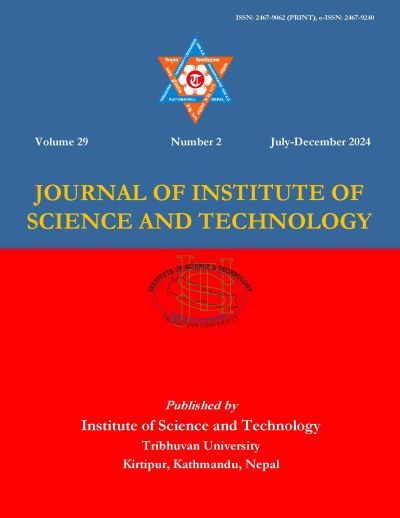Determining the Solvability and Unsolvability of Quadratic Diophantine Equations Using Quadratic Residues and Continued Fractions
DOI:
https://doi.org/10.3126/jist.v29i2.67929Keywords:
Continued fraction, determine, Diophantine equation, quadratic residues, solvabilityAbstract
This paper determines the solvability and unsolvability of quadratic Diophantine equations using quadratic residues and continued fractions. Quadratic residues provide a framework for analyzing the conditions under which these equations have integer solutions, utilizing tools like the quadratic reciprocity law and the Legendre symbol. Continued fractions, particularly the periodic expansion of √D, provide a systematic approach to solving quadratic Diophantine equations like Pell’s equation x2-Dy2=N, where D is a positive, non-square integer and N is a non-zero integer. By combining these methods, we identify the solvability conditions and find integer solutions for quadratic Diophantine equations. The study also incorporates numerical approaches, supported by theorems, and demonstrates the results through illustrative examples.
Downloads
References
Aigner, M., & Ziegler, G.M. (2014). Proofs from the book: Fifth edition. Springer-Verlag, Berlin.
Aleksander, G. (1997). On some connections between Legendre symbols and continued fractions. Acta Academiae Paedagogicae Agriensis, Sectio Mathematicae, 24, 19-21.
Andreescu, T., & Andrica, D. (2015). Quadratic Diophantine equations. USA: Springer.
Arya, S.P. (1991). On the brahmagupta-bhaskara equation. Mathematical Education, 8(1), 23–27.
Austin, M.M. (1981). The Hellenistic World from Alexander to the Roman Conquest: A Selection of Ancient Sources in Translation. Cambridge University Press.
Baumgart, O. (2015). The quadratic reciprocity law: A collection of classical proofs. New York: Birkh Basel.
Burton, D.M. (1980). Elementary number theory. Allyn and Bacon, Boston.
Chowla, P., & Chowla, S. (1972). Problems with periodic simple continued fractions. Proceedings of the National Academy of Sciences, 69, 37-45.
Dudley, U. (2012). Elementary number theory. Courier Corporation.
Friesen, C. (1991). Legendre symbols and continued fractions. Acta Arithmetica, 59, 365-379.
Jacobi, C.G.J. (1837). Uber die kreisteilung und ihre anwendung auf die zahlentheorie. Bericht Ak. Wiss. Berlin.
Legendre, A.M. (1830). Theorie des nombres, third edition. Paris: Libraire Scientifique A. Hermann.
Lemmermeyer, F. (2013). Reciprocity laws: from Euler to Eisenstein. Springer Science and Business Media.
Malik, K.A., & Al Saffar, N.F.H. (2020). On the quadratic reciprocity law. Journal of Discrete Mathematical Sciences & Cryptography, 25(6), 1777-1790.
Mordell, L.J. (1969). Diophantine equations. New York: Academic Press.
Niven, I., Zuckerman, H.S., & Montgomery, H.L. (2013). An introduction to the theory of numbers. John Wiley and Sons.
Riesel, H. (2015). Prime numbers and computer methods for factorization: Second Edition. New York: Birkh Basel.
Schinzel, A. (1974). On two conjectures of P. Chowla and S. Chowla concerning continued fractions. Annali di Matematica Pura ed Applicata, 98, 111-117.
Van der Poorten, A.J., & Walsh, P.G. (1999). A Note on Jacobi symbols and continued fractions. The American Mathematical Monthly, 106(1), 52-56.
Weintraub, S.H. (2011). In Legendre’s work on the law of quadratic reciprocity. The American Mathematical Monthly, 118(3), 210-216.
Downloads
Published
How to Cite
Issue
Section
License
Copyright (c) 2024 Institute of Science and Technology, T.U.

This work is licensed under a Creative Commons Attribution-NonCommercial 4.0 International License.
The views and interpretations in this journal are those of the author(s). They are not attributable to the Institute of Science and Technology, T.U. and do not imply the expression of any opinion concerning the legal status of any country, territory, city, area of its authorities, or concerning the delimitation of its frontiers of boundaries.
The copyright of the articles is held by the Institute of Science and Technology, T.U.




